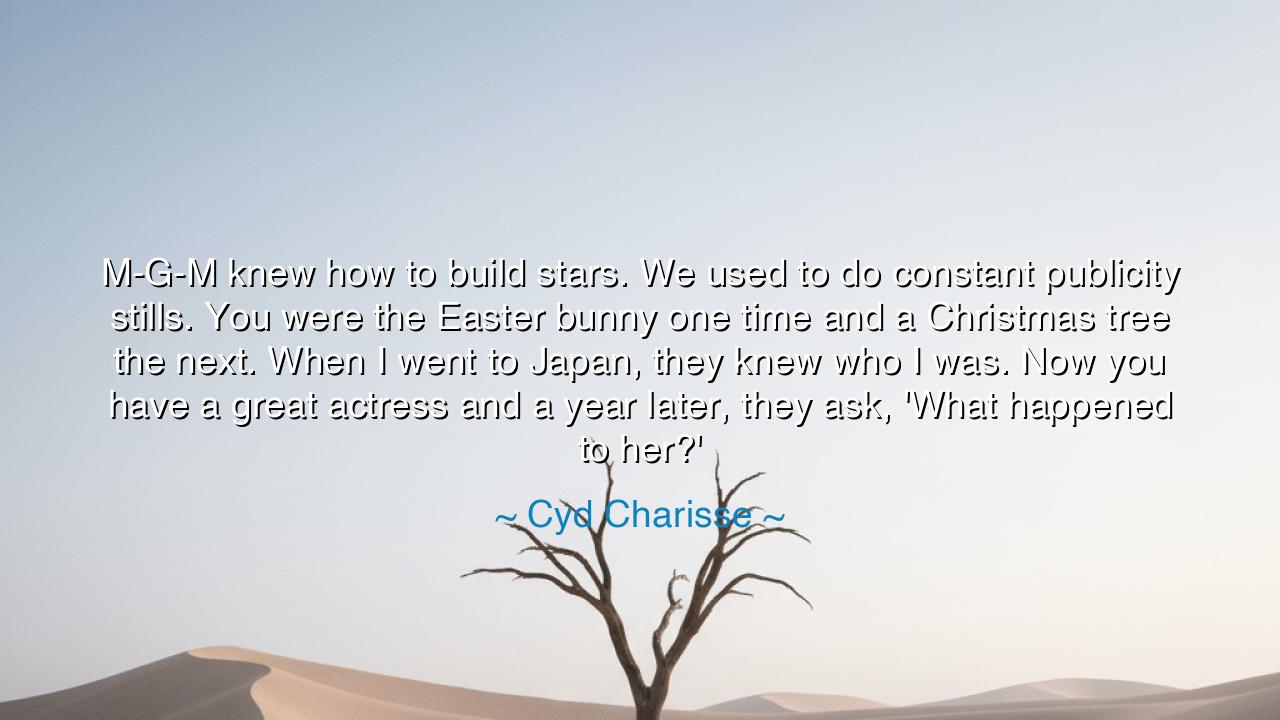
M-G-M knew how to build stars. We used to do constant publicity
M-G-M knew how to build stars. We used to do constant publicity stills. You were the Easter bunny one time and a Christmas tree the next. When I went to Japan, they knew who I was. Now you have a great actress and a year later, they ask, 'What happened to her?'






“M-G-M knew how to build stars. We used to do constant publicity stills. You were the Easter bunny one time and a Christmas tree the next. When I went to Japan, they knew who I was. Now you have a great actress and a year later, they ask, ‘What happened to her?’” Thus spoke Cyd Charisse, the golden dancer of Hollywood’s dream factory, whose grace lit the silver screen in an age when cinema shimmered like myth itself. In her voice is not bitterness, but nostalgia — a lament for a time when art and image, discipline and devotion, were woven together in a way that created legends. Her words are a reflection on fame, craft, and the fleeting nature of modern recognition. They remind us that what once was built to endure is now made to vanish, that what was once sculpted through years of work is now consumed in an instant.
Charisse spoke from within the heart of an empire — Metro-Goldwyn-Mayer, the great citadel of classical Hollywood, where stars were not born, but forged. To “build stars,” as she said, was not merely to showcase talent, but to craft identity — to shape a performer into a symbol that could capture the imagination of the world. The old studios understood that a star was not just an actor, but a constellation of image, story, and mystique. They trained their artists, dressed them, protected them, and yes, displayed them — even as Easter bunnies or Christmas trees — for every occasion, every season, every audience. Through constant labor and vision, they turned ordinary people into immortal names.
In her time, the star system was both a blessing and a burden. It demanded total devotion, yet it bestowed a form of immortality. When Cyd Charisse danced with Fred Astaire or Gene Kelly, she was not merely performing — she was becoming part of something eternal, something that would outlive her. And when she traveled across oceans, to lands she had never seen, she found that her name was already known, her image already adored. That was the power of the old Hollywood machine — it could transform an individual into a universal dream. Fame, then, was not an accident of virality; it was a craft, shaped by patience, artistry, and care.
But her lament — “Now you have a great actress and a year later, they ask, ‘What happened to her?’” — reveals how that world has changed. In her words lies a quiet sorrow for an age where fame is fleeting, where attention burns brightly and dies quickly, where even great talent can vanish beneath the waves of endless new faces. In the modern world, stars rise in moments, not years — and fall just as fast. The culture of the instant has replaced the art of endurance. The image, once a carefully tended flame, is now a spark that flickers and disappears in the wind of forgetfulness.
The ancients, too, knew this truth. They spoke of glory not as something found, but something earned — built through deeds, discipline, and constancy. When Pericles spoke of Athens’ greatness, he said that “fame is the perfume of achievement.” It was not given by whim, nor by fortune, but by lasting excellence. So too, the stars of old Hollywood became eternal because they worked relentlessly, trained endlessly, and upheld their art with reverence. Cyd Charisse’s reflection is a reminder that true recognition — the kind that endures — cannot be manufactured overnight. It must be cultivated, tended, and honored.
Her words are also a lesson in identity. The modern world celebrates visibility, but often at the cost of meaning. To be seen is easy; to be known — truly known, as an artist, a creator, a soul — requires depth and time. Charisse’s lament is not only about the film industry; it is about all of us who live in an age of instant fame and shallow memory. She teaches that to matter, one must build — slowly, steadily, and with purpose. For what is built endures, but what is merely displayed fades.
Therefore, let her wisdom be taken as a call to patience in an impatient age. Whatever you build — your craft, your reputation, your dreams — build it with care. Do not rush to be seen; work to be remembered. Cultivate your art as the gardeners of old Hollywood once cultivated their stars — through discipline, consistency, and devotion. Let the world see not just your image, but your essence. For when the passing fads are forgotten, when the bright noise of the moment fades into silence, only what is true and well-crafted will remain.
And so, as Cyd Charisse once looked back upon the golden age of her art, she left us this enduring truth: Fame may be fleeting, but artistry endures. The stars that shine longest are not those born in a blaze, but those kindled with care and tended with faith. Build your light patiently — and it will guide others long after the applause has ended.






AAdministratorAdministrator
Welcome, honored guests. Please leave a comment, we will respond soon